Louisiana Civil Law of Persons (Family Law)
I believe that legal education should strive to integrate practice and substantive law, as students better retain the substantive law when they understand and see it being used in practice. Introducing practical components in a course, with practicing lawyers, helps to bridge the gap between the academy and the bar and breaks down the traditional compartmentalized approach to legal education. As a result, students exude a greater level of confidence when armed with skills to serve their clients in practice.
This is a course on Louisiana family law, with comparisons made to laws from other jurisdictions when appropriate. The course is taught through fourteen Problem Sets, which present hypothetical scenarios to apply the substantive laws. At the start of the semester, students are put into teams of six to eight students to perform group work in connection with two or three of the Problem Sets. Additionally, students participate in four experiential components, designed to teach client interviewing skills (students witness practicing lawyers interview an actor client), petition drafting (the students draft a petition for divorce and rule for child custody and support), statutory application with a component of oral advocacy (the students complete a child support worksheet and eight students present arguments on custody), and courtroom etiquette (the students visit family court, meet the judge, and write a reflection paper). Students are also required to turn in three take-home questions throughout the semester to prepare them for the final exam and the bar exam, and to provided additional practice in writing cogent legal analysis. Learning goals are set forth in the syllabus, as well as each experiential component.
This an elective course for 2Ls or 3Ls. It qualifies as a “pool” course for students who seek to obtain a Civil Law certificate and must take a requisite number of civil law courses.
My approach seeks to engage every learning style, for example, the visual learner, the auditory learner, and the active learner. I use powerpoint, create an interactive learning environment by using the case method and hypotheticals, introduce group dynamic through problem sets, allow take-home assignments to focus on writing, and bring practitioners in assist in drafting documents. Because of the variety of teaching methods used in one class, I feel that I am cross-teaching to various learning styles, which reaches more students and leads to greater comprehension across various means. This mimics the practice of law where one must understand and assess clients, facts, opposing counsel, the judge, and the law through different mediums by a multitude of people.
I began teaching this way in the fall of 2012 after learning about experiential teaching. It made perfect sense to me—a laboratory style that has been absent in the traditional classroom approach. I contacted local family law practitioners and a judge to discuss the idea of integrating experiential modules into my substantive law class. I worked closely with our Director of Skills and Experiential Learning to decide on learning outcomes and then to seamlessly integrate the modules that could achieve those learning outcomes I wanted to achieve in my course. My approach commits a great deal of time and resources in and outside of the law school to change the classroom experience for the students. Once a year, I meet with the practitioners who assist in the modules and we refine the facts, consider the course evaluations, and add different elements to enhance each experience. I have not abandoned the traditional approach because I think pure statutory and code analysis, along with jurisprudential interpretation, is invaluable to understanding and appreciating the law as well.
I teach the course this way because I am certain the students achieve greater learning outcomes and enter the practice of law with a higher level of confidence. The course now incorporates soft skill training that cannot be tested in a traditional approach. By including practitioners in the classroom, students feel more connected to the profession. Overall, I believe this benefits each student’s professional identity formation. As a law student, I would have embraced experiential learning in the classroom. Not all students have the ability to participate in clinic, so this gives more students the ability to experience, through a simulation, situations that are inherent in clinical pedagogy. In my class, skills are highlighted that will be useful regardless of whether the student ultimately practices family law. Interviewing a client, drafting a petition, making an oral presentation and following pure statutory directives, and visiting a courthouse are all skills that cross various legal careers, even outside of a traditional practice of law. I think the students appreciate having the practitioners in the classroom conducting the experiences and using real world examples of what we discuss in hypothetical format in class. Additionally, for those students who will later pursue our live-client clinics, this class primes them for experiences they will encounter.
Carnegie Apprenticeships
First Apprenticeship:
The course includes the traditional pedagogy heavily weighted in the first apprenticeship. Students study the Louisiana code and case law through the traditional case law method and classroom discussion. Students must study the code articles in order to analyze the hypothetical problems presented for discussion in class. I think statutory and code analysis, along with jurisprudential interpretation, is an important aspect to assess intellectual and cognitive understanding required of professionals.
Second Apprenticeship:
The four experiential components integrate practitioners through each simulation. The client interview and divorce petition drafting exercise allows students to learn through modeling techniques. The students are also able to practice the same skills while collaborating with practitioners through structured class time. This collaboration allows students to develop expert schemas related to interviewing and drafting skills. Students are extremely engaged during the class and practitioners challenge student thinking to provide various experiences related to practice.
Third Apprenticeship:
Students in this class take on the role of an attorney representing the client. The experiential components build upon the same facts and then require students to represent clients on opposite sides in a child support hearing. The exercises highlight the different meaning of facts from opposing points of view and also allow students to build upon their own identity as a professional. One aspect of integrating practitioners in the classroom allows students to ask questions about the demands of practice. Many conversations transpire regarding the values of the profession and the social roles of attorneys in the larger community. Last, the integration of practitioners showcases a highly integrative approach. Most impressive in the course design is the collaboration between clinical, doctrinal, skills faculties and practitioners. This structure eliminates a hidden curriculum and highlights the importance of collaboration within the profession.
Upper Level / Non-Required / Carnegie-Integrated Course
Lecures / Collaborative/Cooperative/Team Learning / Group Discussion / Simulation / Socratic Inquiry / Legal Writing
The students are required to complete six assignments throughout the semester that support my teaching methods. First, after witnessing a client interview, the students are required to draft a petition for divorce and a rule to set child custody and child support for hearing. Second, the students are required to complete a child support worksheet that is provided by statute, using facts derived from a deposition transcript and memorandum from a paralegal. Third, the students are required to visit family court for approximately one to two hours, introduce themselves to the judge, and write a one-page reflection paper on the experience. Last, the students are required to complete three take-home assignments spread throughout the semester, which are exam-type questions on the material covered immediately before the assignment is due. The students must turn in all three assignments, but are only graded on one of them, which is not disclosed to the students.
Through the use of the fourteen Problem Sets, I am able to question students in a large discussion format about the outcomes of the hypotheticals. Through the graded take-home assignment, I am able to evaluate students’ ability to communicate legal analysis in writing. Through the petition drafting and child support worksheet, I am able to evaluate students’ ability to connect the substantive law with practice and use handbooks and statutes to draft legal documents. As mandated by law school rule, students are required to attend eighty percent of the classes each semester for a course in order to take the final exam, so I keep of record of attendance. I also reduce a student’s grade by one-half letter grade if the student is unprepared more than twice during the semester, and I can increase a student’s grade by one-half letter grade if the student participates in a consistent, meaningful way. Finally, I give a traditional exam at the end of the semester that covers the topics presented throughout the semester, which consists of essay and multiple-choice questions. The petition and rule, the child support worksheet, the reflection paper, one take-home assignment, and the final exam are all used in calculating the student’s final grade in the course.
I provide feedback in each class when the students work the hypotheticals in the Problem Sets. For the petition and rule, as well as the child support worksheet, I have created a grading rubric with points awarded for both content and form. When the students receive the assignment, they are provided with a general point breakdown, but not the specific rubric. During the second and third experiential classes, the practitioners review a model divorce petition and rule as well as a child support worksheet. The students are instructed to bring an extra copy of their assignments so that they can take notes during the practitioners’ presentations. For the graded take-home assignment, I provide comments on each paper and I use one class time to review all of the take home assignments.
Over time, I have been able to become more sophisticated in the simulation, for example, by offering a deposition transcript rather than a memo from the partner to present the facts. I have also become more comfortable stopping the practitioners in their presentation to point out “skills to watch for” so I can highlight some of the techniques for the students to recognize. I have learned that while the upstart of integrating experiential modules is great (but with the help of a Director, it is much more manageable), the broad student learning outcomes make the exercises worthwhile. I also enjoy the connection to the practicing bar because we now discuss more often and in more detail interesting legal issues in practice that I can share with my students.
Just do it! I decided to jump in on August 1, 2012, and I was ready to go by the start of school. I had a great deal of help from our Director of Skills and Experiential Learning, but with ideas in place and the commitment to devote four classes to skill-based teaching, I was able to spread them throughout the semester and prepare documents (and now edit documents) during the semester. The students will most definitely appreciate the results (although at times complain about the increased work load) but understand the importance of getting their hands dirty to fully engage in legal education.
My evidence of student learning and indicators of effectiveness have come from student feedback immediately after the course and antidotal evidence after students have graduated. We created an evaluation form to assess the student learning for each experiential component. We study this evaluation form for methods to improve learning effectiveness. Although I have no direct measure of effectiveness, the writing on my final examinations has been more organized I believe in part as a result of the review and comments written on the take-home assignments.
I plan to continue these experiences. I have introduced three new practitioners to the exercises, so I now have a total of five practitioners and the practitioner who acts as the client. Our clinic professor who runs the family law clinic also participates in every experience, which adds another point of view. The increased participation helps to avoid conflicts in the practitioner’s schedules because I believe two practitioners plus the clinic professor is the perfect balance to run the experiences. I also plan to replace some facts in the memo with documents to support the facts, for example, including tax returns and W2s rather than provide gross income figures.



